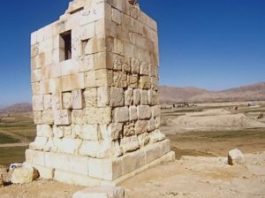Name
Nūrabad, Dom-e Mil دم میل،نوراباد
Ali Mousavi, November 30, 2023
Location: Dom-e Mil is located to the west of Nūrabad, in western Fars, Fars Province.
30°06’06.1″N 51°27’17.4″E
Map
Historical Period
Sasanian
History and description
The isolated stone tower of Dom-e Mil is 8 km west of the present-day town of Nūrabad, and 120 km north of Kazerūn, in western Fars. The tower is in ashlar masonry and stands on a two-tiered base on a gentle slope of a rocky plateau (fig. 1). At present, the tower’s height is 6.8 m above the base and a total of 8 m including the base. The tower has a side length of 3.40 m. Its entrance is situated on the south side and stands 2 m above the current ground level. The presence of a staircase leading to the entrance is uncertain. The opening of the entrance measures approximately 75 x 60 cm. Within the tower's chamber, a small, narrow spiral staircase made of stone blocks ascends to an upper story, some parts of which are destroyed. In the absence of any written record, the use of ashlar masonry and the proximity of the tower to Shapur I’s city of Bishapur suggest a date in the late 3rd century. Regarding the function of the tower, two main theories have been postulated so far. It is either a tomb or a fire temple; a recent reconstruction is based on the latter attribution (fig. 2). The former theory has gained prominence as Dietrich Huff’s meticulous study of the tower and its environs showed that the entire tower could be a depository of bones or astūdan.
Fig. 2. A computer-generated reconstruction of the Dom-e Mil tower at Nūrabad by Hamed Mohammadpour (Image: Courtesy of H. Mohammadpour).
Archaeological Exploration
The first recorded visit to the Dom-e Mil tower dates back to the 19th century when Franz Stolze and Friedrich Carl Andreas traveled to Fars between 1876 and 1881, capturing the first photograph of the monument. Subsequently, George N. Curzon mentioned the monument without apparently having seen it. In the spring of 1905, Ernst Herzfeld visited the monument and referred to it as Mil-e Azhdeha (The Dragon’s Pillar). Herzfeld rightly recognized the similarity between this tower and the one erected at Paikuli, suggesting a date in the early Sasanian period. In the years following World War II, Roman Ghirshman studied the Dom-e Mil tower and was convinced that it was a fire temple. Careful re-examination of the tower and its whereabouts was carried out by Dietrich Huff, then a member of the German Archaeological Institute, in 1972.
Bibliography
Curzon, G. N., Persia and the Persian Question, vol. 2, London, 1892, pp. 145-146.
Ghirshman, R., “La tour de Nourabad. Étude sur les temples iraniens anciens,” Syria, vol. 24, fasc. 3/4, 1944-1945, pp. 175-193.
Herzfeld, E., “Reisebericht, ” Zeitschrift der Deutschen Morgenländischen Gesellschaft , vol. 80/4, 1926, p. 258 (for Nūrabad).
Huff, D., “Nurabad, Dum-i Mill,” Archaeologische Mitteilungen aus Iran, vol. 8, 1975, pp. 167-209.
Sami, A., Pasargadae. The Oldest Imperial Capital of Iran, Shiraz, 1956, pp. 89-93 (for Nūrabad).
Schippmann, K., Die iranischen Feuerheiligtümer, Berlin, 1971, pp. 153-160 (for Nūrabad).
Stolze, F. and F. C. Andreas, Persepolis, die achaemenidischen und sasanidischen Denkmäler und Inschriften von Persepolis, Istakhr, Pasargadae, Shâhpûr, Berlin, 1882, vol. 2, pl. 147.
Vanden Berghe, L., L’archéologie de l’Iran ancien, pp. 56-57 (for Nūrabad).



 DOWNLOAD AS PDF
DOWNLOAD AS PDF

















































































































